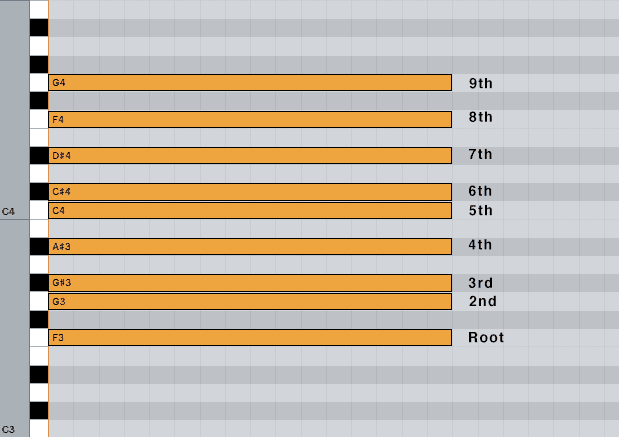Chords are a tricky business, but they are really important to your tracks. In almost all genres, chords will be present in your track in some way or function and knowing how to do them properly can set you apart from the rest. Whether using it for pads, pianos, sawtooth drops, all these elements use a chord structure and the way you voice it can change everything.
In this post, we’ll make a chord progression and transform it from a simple chord progression into something a lot more developed and interesting with these four chord tricks. Of course, since this is a post, I expect you to follow along and try this out with the midis available in this link. If you can’t follow along right now, try them later in your studio. Here are the techniques that we’ll check today:
- Chords Inversions
- Shifting the Initial Chord Hits
- Adding Chord Variations
- Enhancing Your Chords With Additional Chords
Here’s our starting chord progression, which is in Fmin. It’s a simple progression composed of the chords Fmin, G#maj, A#min. However, it’s a bit too simple since it’s just using triad chords and too static since it’s stuck to the 4/4 grid and doesn’t move that much. Therefore, I’ll show you today 4 tricks to improve your chords.

Chords Inversions
The problem with the chord progression above is that, although static, it moves too much in the piano. Imagine yourself playing this with your hands and you would have to move them a lot to get to the next chord, specially from A#min to Fmin as it is over there.
Besides that, if we play it like this, we can make the sound vary too much. For example, the sound of the A#min would be too high when compared with Fmin, which may not be pleasant to listen to in song. That’s why, in this case, we’ll do an Inversion, which is to put the highest note of G#maj and A#min one octave down, making the fifth note become the lowest note of the chord.

Now, when playing the triad of G#maj, the fifth note (D#) is the lowest note of the chord due to our inversion. It’s still the same chord, but this makes a big difference to make the sound be more even throughout the chord progression, avoiding it to be too high in some moments and too low in others.
Shifting the Initial Chord Hits
Instead of having the chords hitting exactly along with the beat, why not shift them a bit? One trick you can do with your chords is delaying or anticipating them so they don’t play on the grid all the time. What is nice about this change is that it creates a bit of rhythm and variation to the chord:

Adding Chord Variations
To make things more interesting, I will change the last part of G#maj and A#min, adding a new chord (D#maj), which will make our progression look like this:

This adds a little more of variation and makes our chord sound more interesting. In a world where the attention span of the listener is really short, this would help maintain the listener’s interest in your progression.
It’s important to mention that the amount of variation you should insert in your chords depends immensely on how much your genre varies itself. For example, adding more variation to this progression could be too much for progressive house, but it could be too simple for a future house. Therefore, be aware that the “limit” is your genre, but even then you can try to break it.
Enhancing Your Chords With Additional Chords
A triad chord is composed of your root note, third note and a fifth note. However, many genres are going further than only using triads for their chords and started adding other notes in the chord besides these three.
A Seventh chord, as a well as a Ninth or Sixth chord, is a chord using the triad along with the seventh, ninth or sixth note of the scale, respectively. It’s important to mention that not necessarily you need to have the triad as well to be considered a seventh chord since what characterizes it is the seventh note itself.
If we’re looking at the Fmin scale, here are the available notes we’d have:

A Seventh + triad chord would be, therefore, something with F + G# + C + D#. However, I can also invert this D#, and instead of playing it higher than C, I’ll play it lower than F. Same will apply to all other chords in the scale and our progression will now look a bit like this:

By adding these notes, you’ll make your chords much more interesting than just regular triads. This can improve your track drastically, especially if the chords play a big role in it.
———————
Now it’s your turn
There you have it: my four top techniques to enhance your chord progressions.
Now I’d like to hear what you have to say:
Which one of these techniques from this list are you going to implement first?
Leave comment below: